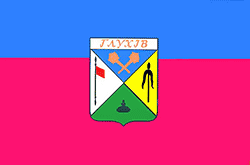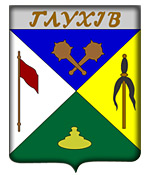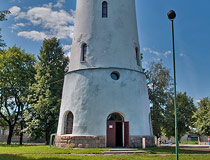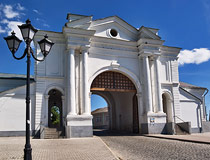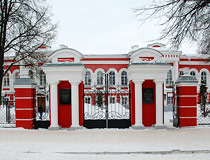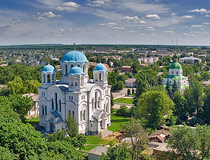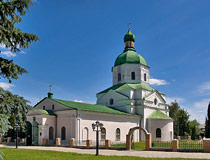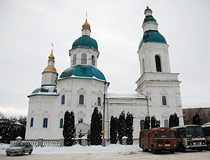Hlukhiv - Overview
Hlukhiv is a town located in Sumy Oblast of Ukraine. It is a major historical center of Eastern Polesia and an important cultural center of Ukraine.
The population of Hlukhiv is about 31,700 (2021), the area - 84 sq. km.
The phone code - +380 5444, the postal code - 41400.
History of Hlukhiv
Hlukhiv is one of the oldest towns of Kievan Rus’. The first mention of it, as a fortress town of the Chernihiv principality, is dated 1152. Indirect historical sources mention it in 992.
In 1352, the plague wiped out nearly all of its residents (according to the chronicle, nobody survived). Because of the high mortality rate, the town turned into one of the many small settlements and lost its former importance. In the 1350s, Hlukhiv was captured by the Grand Duchy of Lithuania. In 1503, as a result of the war, it was lost to the Grand Duchy of Moscow.
In 1618, under the terms of the Delinsky truce, Hlukhiv became part of the Commonwealth. In 1644, the town received the Magdeburg Law. In 1648-1654, the residents of Hlukhiv participated in the Khmelnytsky uprising (the Cossack-Polish war). In 1654, as part of the Left-Bank Ukraine, the town again came under the control of Moscow.
In the period from 1708 to 1764, Hlukhiv was the seat of Ukrainian Hetmans. In the 1840-ies, this town, because of its location on the main route between Kyiv and Moscow, took key positions in the trading business. Hlukhiv became the center of the grain trade in the Left-Bank Ukraine.
More historical facts…
In the second half of the 19th century, economic transformations began, the architectural and cultural revival of Hlukhiv began, mainly due to local patrons, primarily the famous Ukrainian sugar manufacturer N.A. Tereshchenko, an entrepreneur who founded several sugar, sawmills and distilleries around Hlukhiv. In 1859, 11,464 people lived in Hlukhiv, there were 1,103 houses.
In 1874, a teacher’s institute was founded in the town. Later, men’s and women’s gymnasiums, a vocational school and two hospitals were opened. In 1895, a railroad was laid in Hlukhiv, which improved the economic situation of the town and its connection with other regions of the Russian Empire.
During the Second World War, from September 7, 1941, to August 30, 1943, Hlukhiv was occupied by German troops. In honor of the liberation of the city, on September 1, the City Day of Hlukhiv is celebrated every year. Hlukhiv was rebuilt in 1943-1950. According to the 1959 census, 22,962 people lived in the city.
In 1989, the city’s population was 35,869. After the declaration of independence of Ukraine, the number of industrial enterprises decreased and the city became a cultural and historical center. In 1992, Hlukhiv celebrated its millennium. In 1994, the State Historical and Cultural Reserve was created in Hlukhiv.
Since the beginning of the 21st century, restoration of historical and cultural sites of Hlukhiv began.
Hlukhiv - Features
Hlukhiv is located in the north-eastern part of Ukraine, within the most low-lying parts of Ukrainian Polesia, about 146 km from Sumy, the capital city of the region. The height above the sea level is 160 meters; the central part of the town is a high hill with steep slopes.
The climate is temperate continental with cool winters and warm summers. The average January temperature is minus 7.7 degrees C, the average July temperature is plus 19.2 degrees C.
In 2005 and 2009, Hlukhiv was recognized as a city with the cleanest air in Ukraine.
Streets of Hlukhiv
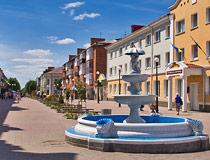
Architecture of Hlukhiv
Author: Igor Kopitsa
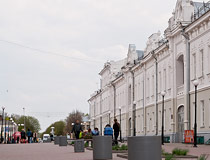
The main street of Hlukhiv
Author: Tanya Zabula
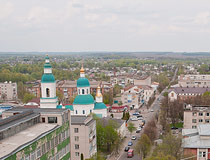
General view of Hlukhiv
Author: Tanya Zabula
Main Attractions of Hlukhiv
Hlukhiv Water Tower. This picturesque 41 meters high water tower, built in 1927-1929, is one of the symbols of Hlukhiv. The tower is visible from several kilometers away. It is an expressive element of the city’s architectural silhouette.
An internal spiral staircase leads to the upper level with an observation deck, which offers a magnificent view of the city and its beautiful surroundings. Tereschenkiv Street. Opening hours: 10:00-17:00.
Kyiv Gate. It is the only preserved structure of the Hlukhiv fortress, one of the four former entries in the territory of the old town. Kyievo-Moskovska Street, 1.
Hlukhiv Pedagogical University. This complex of educational institutions was built in the second half of the 19th century. Today, it is occupied by the Hlukhiv State Pedagogical University named after A. Dovzhenko. There is a historical and educational museum in the university. Kyievo-Moskovska Street, 24.
Tereshchenko House. The oldest surviving building of architectural heritage of the Tereshchenko family constructed in 1866. Tereschenkiv Street, 45.
Hlukhiv Archaeological Museum. This museum was opened in a renovated manor house in 2008. Its exhibition includes ceramics, tools, clothing, building materials found on the territory of Hlukhiv. The museum staff also arranges city tours. Shevchenka Street, 30.
Hlukhiv Local History Museum. Founded in 1902, it occupies a two-storey building (1811) constructed in the style of provincial classicism. The exhibition covers the history of Hlukhiv from old times till the second half of the 20th century.
There are five halls: the Hall of Nature, the Medieval Town, the Hetman Hall, Hlukhiv in the 19th century, Hlukhiv in the Second World War. Tereschenkiv Street, 42. Opening hours: 9:00-16:00, day off - Monday.
Three Anastasias Cathedral. This beautiful church named after three holy Anastasias was rebuilt in Hlukhiv by means of the Tereshchenko family 1884-1897 and became their ancestral burial. The largest church in Hlukhiv, it resembles St. Volodymyr’s Cathedral in Kyiv. Spaska Street, 2.
Transfiguration Church. This stone church, built in 1765, is one of the architectural landmarks of Hlukhiv, an architectural monument of national importance. In Soviet times, the church was closed. In the 1980s, restoration work was done, and, in 1989, the church was returned to believers. Spaska Street, 4.
St .Nicholas Church. This church is the oldest architectural monument in Hlukhiv built in 1693-1695, a monument of history and architecture of national and world significance. It is considered the only one of the many churches built by the outstanding architect Matfey Efimov that have survived to this day. Soborna Square, 1.


